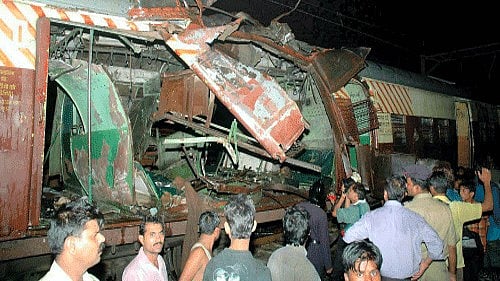
Known as Urbs Prima in Indis, Mumbai is home to the who’s who of India. It is a city of stark contrasts—home to high-rises and slums, rich and poor, with a big middle-class population. As India’s financial, banking, business, and entertainment capital, Mumbai has also become a frequent target for terrorist groups.
Mumbai has witnessed several terror attacks over the years, but three stand out for their scale and impact: the 1993 serial blasts, the 2006 train bombings (7/11), and the 2008 fidayeen attacks (26/11).
On March 12, 1993, a series of RDX-based bombs exploded at a dozen places across Mumbai. The deadliest terror strike to date, the blasts killed 257 people and injured over 713. Property worth Rs 27 crore was destroyed.
The Mumbai Police, often hailed as second only to Scotland Yard—and perhaps better, according to some—swiftly traced the attack to Pakistan-based underworld don Dawood Ibrahim. Of the 123 accused put on trial, 100 were convicted by a Special TADA Court and 23 were acquitted. Yakub Memon, brother of absconding accused Tiger Memon, was sentenced to death and hanged. The sheer scale and volume of the case have led some to describe it as even larger than the Nuremberg Trials. The case was later handed over to the CBI, which set up a Special Task Force, and some trials are still ongoing.
The 2008 (26/11) Mumbai attacks were live-tracked by intelligence agencies. Nine fidayeens were killed, and the lone surviving terrorist, Mohammed Ajmal Kasab, was swiftly tried and executed. The Crime Branch-CID of the Mumbai police handled the investigation.
On the other hand, 7/11 was a blinder of a case. This time the target was the urban transportation system. On the evening of July 11, 2006, seven coordinated blasts tore through first-class train compartments of Mumbai’s crowded suburban trains, killing 189 and injuring over 800. The attack rattled Mumbai and sent shock waves across the country.
The train bombings tell a different story—one of investigative lapses, legal challenges, and an eventual collapse of the prosecution’s case. The investigation was shifted from the Railway Police to the Anti-Terrorism Squad (ATS). The role of Pakistan-based Lashkar-e-Taiba (LeT), the ISI, and the outlawed Students Islamic Movement of India (SIMI) was suspected. The main person behind the chain bombing was Azam Cheema, alias Babaji, the Bahawalpur-based Lashkar commander, who doubled up as an ISI operative. Thirteen people were arrested and booked under various provisions of the Indian Penal Code and the Maharashtra Control of Organised Crime Act (MCOCA).
In September 2015, a special MCOCA Court, presided over by then Additional Sessions Judge Y D Shinde, acquitted one and convicted 12 of the accused, awarding the death sentence to five—Kamal Ansari, Mohammad Faisal Ataur Rahman Shaikh, Ehtesham Qutubuddin Siddiqui, Naveed Hussain Khan, and Asif Khan—and life imprisonment to the rest. Kamal Ansari died in 2021.
But last week, in a stunning reversal, a division bench of the Bombay High Court acquitted all 12. The court found significant flaws in the investigation, including reliance on confessional statements and mishandling of evidence, besides issues with the application of MCOCA provisions.
The judgement, delivered by Justices Anil Kilor and Shyam Chandak, went further and cautioned against a dangerous trend in law enforcement: the temptation to create a false appearance of resolution. “Punishing the actual perpetrator of a crime is a concrete and essential step toward curbing criminal activities, upholding the rule of law, and ensuring the safety and security of citizens. But creating a false appearance of having solved a case by presenting that the accused have been brought to justice gives a misleading sense of resolution. This deceptive closure undermines public trust and falsely reassures society, while in reality, the true threat remains at large.”
The Supreme Court has stayed the High Court ruling from being treated as a precedent in other MCOCA cases, pending further proceedings.
For the then Commissioner Anami Narayan Roy, the verdict came as a shock. “We presented a strong case to the court through the charge sheet… We did not do any witch hunt. We only charge sheeted those who played a core role in the blast,” he said.
But inconsistencies surfaced over the years. The prosecution initially claimed that the bombs were concealed in pressure cookers to increase the impact, yet this detail was missing from the original charge sheet and emerged only during trial. The accused had challenged the application of MCOCA.
Some of the accused and arrested were also linked to other terror cases—the Malegaon-I blasts of September, 2006, and the earlier Aurangabad arms haul—indicating a complex, interconnected network of operatives. Further complicating the picture is the role of Zaibuddin Ansari, alias Abu Jundal, wanted in multiple cases, including the 26/11 attacks, the 2010 German Bakery blast in Pune, and the Aurangabad arms haul. In September 2008, the Crime Branch unearthed an Indian Mujahideen network—including the Pune module—linked to many of these attacks. Some IM operatives had also reportedly masqueraded as “Pakistanis” and were part of the group that carried out the 7/11 orchestrated bombing in local trains.
Case records now suggest a clear operational triangle between the Aurangabad arms haul, the 7/11 train blasts, and the Malegaon attacks. Yet, nearly two decades later, the core perpetrators of 7/11 may still be at large. While Mumbai has often responded swiftly to terror attacks, the 7/11 case underscores flaws in the investigative process and has left more questions than answers.